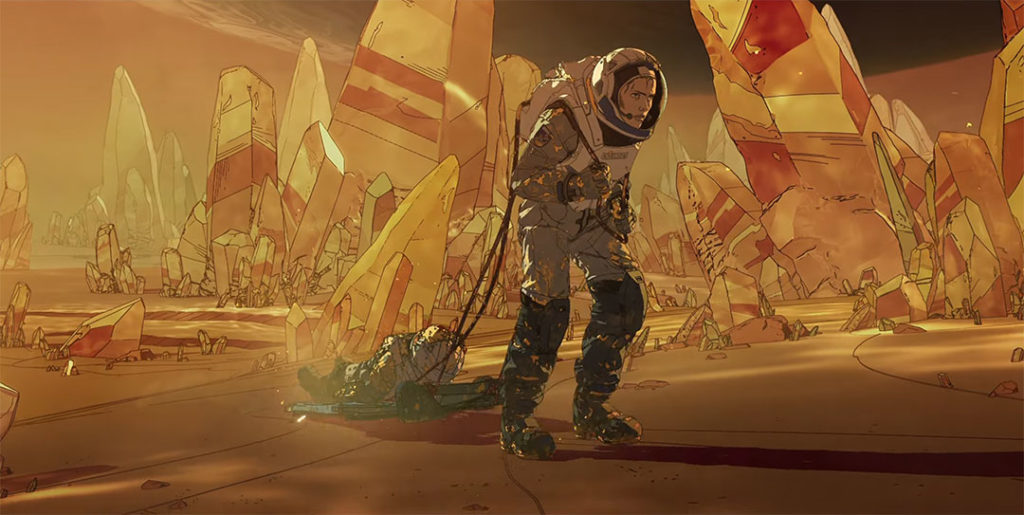Love, Death & Robots S03
May 23, 2022 · 0 comments
By Andrew Osmond.

I’ve previously reviewed seasons one and two of Netflix’s anthology series Love, Death and Robots, and found it an interesting if erratic mix of adult animation and real SF. It was at its best when it transcended its origins as a sex and violence shocker. Standout episodes included “Zima Blue,” a post-human meditation on art, animated by the Passion studio, and “The Drowned Giant,” a sardonic story of a dead Gulliver being disassembled by wee Lilliputians. These episodes were based respectively on stories by Alastair Reynolds and J.G. Ballard.
I found season two an improvement on the first, with fewer but mostly better episodes. However, season three, which has just dropped onto Netflix, is a disappointing step back, albeit with highlights worth noting.
One of those highlights is “The Very Pulse of the Machine,” the first episode of the series to be animated by a Japanese studio. In this case, it’s Polygon Pictures, the CG studio known for Knights of Sidonia, Ajin, Ronja (produced by Ghibli) and multiple anime with Godzilla and the Transformers. Polygon also animated Netflix’s Pacific Rim: The Black, which ended this April.
The “Pulse” episode is directed by the Asian-Australian Emily Dean, whose first film can be seen here. It’s based on a story by Michael Swanwick (The Iron Dragon’s Daughter). The template is familiar. A female traveller on Io, one of Jupiter’s moons, struggles for survival when her craft is destroyed. As she toils over the desert, she’s assailed by voices and visions that may be side-effects of her meds, or they may be something more; a situation not unlike that in Amazon’s adult animation series Undone.

“Pulse” may be the best-looking Polygon animation I’ve seen. The toon-shaded CG is standard, but the use of colours is immensely pleasing, with the yellow-hued backgrounds putting me in mind of vintage SF films. Moreover, the bold colours also reminded me of the 1981 Heavy Metal film that heavily inspired Love, Death and Robots… only without that film’s crass sex and nudity. “Pulse” has rippling giants in the landscape, and whispered poetry in the heroine’s ear. The story ends like Akira with a voice from some unknown dimension, speaking out to the universe.
Another clear highlight is the episode “Jibaro,” which feels like a revved-up reply to last year’s quest-subverting film The Green Knight by David Lowery. In “Jibaro,” a deaf knight sees his comrades slaughtered by a wailing, gyring, gold-plated siren on a lake. Hard to process on first viewing, this is a broken, panicked, disorienting experience told through aggressively fractured editing and sound (there’s no real dialogue), mercilessly treating its cast as puppets.

It marks the return of the Spanish animator Albert Mielgo. He previously made the first-season episode “The Witness,” which I found wild but ugly, its achievements smothered in violence and nudity. While that film seemingly had live-action elements, Mielgo has said it was entirely keyframed CG (not mo-capped) and the same may apply to “Jibaro.” His new film is still hardly easy viewing, but it’s jarringly impressive, demanding repeated perusal.
Of the other new episodes, the CG “Swarm” is a good SF tale, following two humans swimming through the mazes of a millions year-old alien hive. Eventually, the wonder gives way to squicky horror, though the hive is a wondrous SF environment that’s bracing and painful. It’s directed by Deadpool’s Tim Miller and based on a story by Bruce Sterling.
David Fincher, no less, has his first director credit on an individual episode – he’s been an executive producer on Love, Death and Robots since the start. It would be nice to say the director of Se7en and Fight Club comes up with something exceptional. Instead he gives us the merely good “Bad Travelling,” a solid, sticky sea horror tale of a sailing ship under the claws of an intelligent cephalopod. Much flesh is devoured before a fiery climax that had me expecting some last twist… though maybe the point is there’s no more to say.

Based on a story by Neal Asher, this is another CG film by Tim Miller’s Blur Studio, which also made “Swarm,” though “Bad Travelling” is more stylised. The sea is fittingly grim and sunless; the sailors feel like refugees from an engraving. As for the huge-toothed crab monster, it’s really disgusting.
Unfortunately, the other five stories are all diminished returns. “Three Robots: Exit Strategies” is a sequel to the first-season story about robots exploring a destroyed world, but has little to add. The other stories are all monster yarns, heavy on the gore but quickly forgettable. Jennifer Yuh Nelson, late of the Kung Fu Panda franchise, plainly has fun with the gross-out 2D animation “Kill Team Kill”, but we’ve seen it before – well, except for the soldier pissing on the “camera” to get us in the dick-waving spirit.
Over the last twelve months, adult animated series have continued evolving outside Japan. Netflix itself has the superb class-war fantasy Arcane: League of Legends, by the Paris studio Fortiche; I’ve reviewed it elsewhere. In March last year, Amazon debuted the superhero series Invincible, whose bloodbath set-pieces actually had emotional weight. Beside them, Love, Death and Robots is starting to look redundant, and we know how Netflix deals with unwanted animation these days.
Andrew Osmond is the author of 100 Animated Feature Films. Love, Death and Robots is currently streaming on Netflix.
Leave a Reply